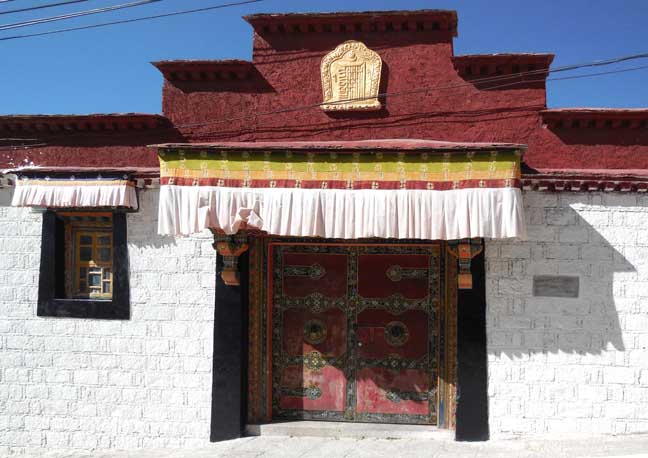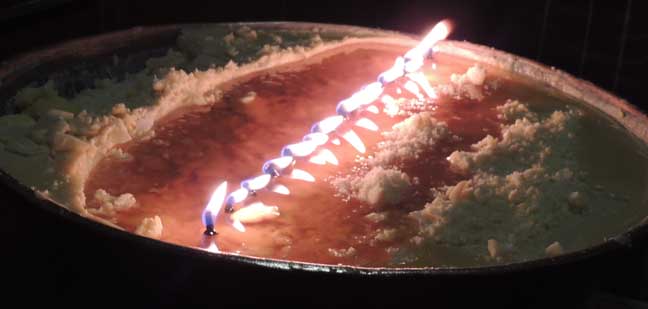
Tibet - Table of Contents ............... Architecture Around the World
Sera Monastery
near Lhasa, Tibet
Pronounced SAIR a
Below, on this page:
| Sera
Monastery, founded in 1419, is one of the great three Gelukpa
university monasteries of Tibet, located 1.25 miles north of
Lhasa. During the 1959 revolt in Lhasa, Sera monastery suffered severe damage, with its colleges destroyed and hundreds of monks killed. After the Dalai Lama took asylum in India, many of the monks of the Sera Monastery who survived the attack moved to India. - Information culled from Wikipedia (online December 2013)
|
| The architectures of Tibetan
Buddhism gradually developed from just niches and ritual halls [in
palaces] to independent building complexes, and eventually separated
from the palace architectures, after the extensive spreading of
Buddhism and strong supporting by Songtran Ganpo and his successors.
The early Buddhist temples were built under the patronage of the Tubo
rulers. But later on the Buddhist followers began to fund the
construction of the monasteries. A monastery architecture is a large sized building complex consisting of temples and halls, residence quarters of monks, stupas and several colleges. - Tibetan Monastery Architectures (online December 2013)
|
Entrance Gate Entrance gate  Entrance gate  Entrance gate. Dharma wheel and double deer.
Dharma wheel of life (Dharmacakra): Dharma is the Buddha's
teaching of the path to enlightenment. All Buddhists agree that the
original turning of the wheel occurred when the Buddha taught the five
ascetics who became his first disciples at the Deer Park in Sarnath.
Buddhist teachings are called "turnings" of the dharmachakra. In memory
of this, the Dharmachakra is sometimes represented with a deer on each
side. A traditional dharma wheel is a chariot wheel with varying number of spokes. It can be in any color, although it is most often gold. At the center sometimes there are three shapes swirling together, although sometimes at the center is a yin-yang symbol, or another wheel, or an empty circle. A dharma wheel has three basic parts -- the hub, the rim, and the spokes. Over the centuries various teachers and traditions have proposed diverse meanings for these parts. The number of spokes may vary from 4 to 31. The Dharma wheel is recognized globally as a symbol for Buddhism. In 1947, the government of India adopted a new national flag, in the center of which is a navy blue Ashoka Chakra on a white background. The Dharmachakra is also the U.S. Armed Forces military chaplain insignia for Buddhist chaplains. |
Monastery grounds   Note prayer wheels  Note prayer wheels behind the three visitors  Visitor breathes in incense to purify herself. At some temples, visitors burn incense (osenko) in large incense burners. Purchase a bundle, light them, let them burn for a few seconds and then extinguish the flame by waving your hand rather than by blowing it out. Finally, put the incense into the incense burner and fan some smoke towards yourself as the smoke is believed to have healing power. For example, fan some smoke towards your shoulder if you have an injured shoulder.  Parents and children in line to receive medical treatment for children through blessing  Same line    Details below:  More details below:  More details below:  Doorway detail. More details below:  Doorway detail. More details below:  Doorway detail. More details below:  Doorway detail: painted wooden post      Note building - a nunnery - in upper right photo.  Nunnery  Painted rocks  Painted rocks |
Tsogchen Main Assembly Hall  Pilgrims slide face down on a mat in front of the main assembly hall (below)  Tsogchen Main Assembly Hall The largest and most striking building in the complex is the Tsogchen located farthest up the hill. It dates back to 1710. Since the 11th century, most of the Tibetan monasteries were built with the main hall in the center. "With the gradual development of
all sects of Tibetan Buddhism, the number of monks increased, the main
hall previously used as the shrine of Buddhas and Bodhisattvas was
gradually changed to the important arena for the monks to study, meet
and meditate. The designers paid more attention on both the enlargement
of the space and the lightening effect. They added top
windows... They also decorated on the golden roofs of the
buildings with the sculptures of animals and objects, such as the
double deer, dharma wheels and victory banners, making the whole
constructions glittering with the golden shine." -
 Tsogchen Main Assembly Hall  Dharma wheel and double deer.
Dharma wheel of life (Dharmacakra): Dharma is the Buddha's teaching of
the path to enlightenment. All Buddhists agree that the original
turning of the wheel occurred when the Buddha taught the five ascetics
who became his first disciples at the Deer Park in Sarnath. Buddhist
teachings are called "turnings" of the dharmachakra. In memory of this,
the Dharmachakra is sometimes represented with a deer on each side.
A traditional dharma wheel is a chariot wheel with varying number of spokes. It can be in any color, although it is most often gold. At the center sometimes there are three shapes swirling together, although sometimes at the center is a yin-yang symbol, or another wheel, or an empty circle. A dharma wheel has three basic parts -- the hub, the rim, and the spokes. Over the centuries various teachers and traditions have proposed diverse meanings for these parts. The number of spokes may vary from 4 to 31.  Tsogchen Main Assembly Hall - Interior mural  Tsogchen Main Assembly Hall - Mural detail  Tsogchen Main Assembly Hall - Mural detail  Tsogchen Main Assembly Hall - Mural detail  Tsogchen Main Assembly Hall - Mural detail  Tsogchen Main Assembly Hall - Mural detail  Photos taken on November 24, 2013, the Tibetan Lhabab Duchen Festival. Lhabab Duchen is a Tibetan festival commemorating a story told of the historical Buddha, who is called "Shakyamuni Buddha" by Mahayana Buddhists. In this story, the Buddha had been teaching celestial beings, including his mother, in one of the god realms. A disciple begged him to return to the human world, and so Shakyamuni descended from the god realm on three ladders made of gold and gems. This is only day that all the monks in Sera assemble in this hall.   Tsogchen Main Assembly Hall  Tsogchen Main Assembly Hall  Tsogchen Main Assembly Hall    Tsogchen Main Assembly Hall - detail below  Tsogchen Main Assembly Hall - detail   Detail below:  Tsogchen Main Assembly Hall. Detail below:  Tsogchen Main Assembly Hall - detail  Tsogchen Main Assembly Hall. Detail below:  Tsogchen Main Assembly Hall. Detail  Tsogchen Main Assembly Hall. Details below:  Tsogchen Main Assembly Hall. Detail is distorted intentionally to show features of the upper figures. Another detail below:  Tsogchen Main Assembly Hall. Detail  Tsogchen Main Assembly Hall  Tsogchen Main Assembly Hall. Yak butter - gifts from worshipers - is added throughout the day. Photos and their arrangement © 2013 Chuck and Nancy LaChiusa ..| ..Home Page ...| ..Buffalo Architecture Index...| ..Buffalo History Index... .| ....E-Mail ...| ..  web site consulting by ingenious, inc. |